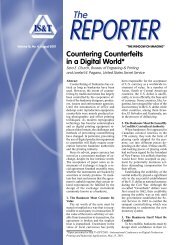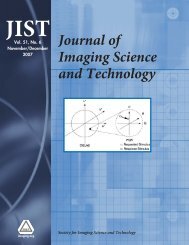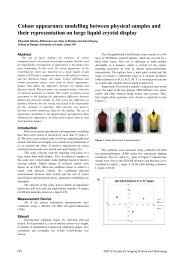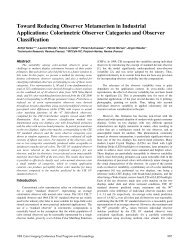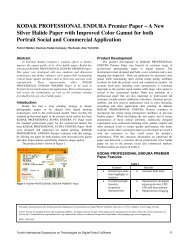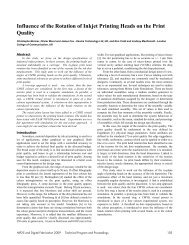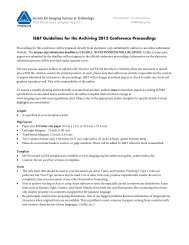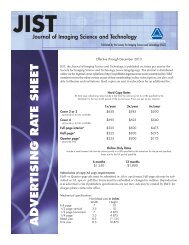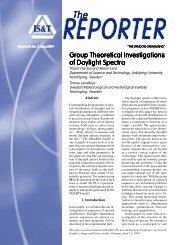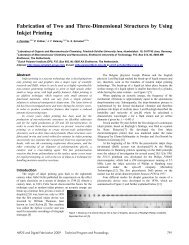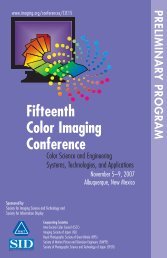HP-Indigo Technology and its Application to Photo Printing
HP-Indigo Technology and its Application to Photo Printing
HP-Indigo Technology and its Application to Photo Printing
Create successful ePaper yourself
Turn your PDF publications into a flip-book with our unique Google optimized e-Paper software.
<strong>HP</strong>-<strong>Indigo</strong> <strong>Technology</strong> <strong>and</strong> <strong>its</strong> <strong>Application</strong> <strong>to</strong> Pho<strong>to</strong> <strong>Printing</strong><br />
Boaz Tagansky; Hewlett Packard Company; Rehovot, Israel<br />
Abstract<br />
<strong>HP</strong>-<strong>Indigo</strong> technology delivers superb print quality at a high<br />
printing speed over a wide range of substrates, including glossy<br />
matt <strong>and</strong> textured papers, as well as pho<strong>to</strong> or other non paper<br />
substrates. Together with <strong>its</strong> flexibility <strong>and</strong> end <strong>to</strong> end solution<br />
portfolio it brings state of the art capabilities <strong>to</strong> a variety of pho<strong>to</strong><br />
applications, making <strong>HP</strong>-<strong>Indigo</strong> the dominant player in the digital<br />
pho<strong>to</strong> printing market.<br />
<strong>HP</strong> <strong>Indigo</strong> digital presses use liquid electropho<strong>to</strong>graphy<br />
based on ElectroInk®, with a hot transfer blanket. After<br />
electrically charging the pho<strong>to</strong>conduc<strong>to</strong>r a latent image is created<br />
by a multi-beam laser scanning unit. Then ink is developed on<strong>to</strong><br />
the latent image by one of the various colored ink development<br />
stations. After ink transfers <strong>to</strong> the blanket using electric field, the<br />
carrier liquid is evaporated off the hot blanket, <strong>and</strong> the resultant<br />
hot melted ink film is transferred <strong>to</strong> the substrate by means of<br />
pressure <strong>and</strong> tackiness. This process is repeated once for each<br />
color.<br />
During the printing process a nearly solid ink image is<br />
created on a blanket, subsequently adhered <strong>to</strong> the surface of the<br />
substrate with almost no change <strong>and</strong> without penetrating in<strong>to</strong> the<br />
media. Thus the high image quality is independent from the<br />
substrate characteristics. In addition, the ink layer is thin enough<br />
<strong>to</strong> achieve the feel of the substrate, so by choosing the substrate<br />
one can control the feel of the image, without compromising on<br />
image quality.<br />
The flexibility of the technology enable both sheet fed <strong>and</strong> web<br />
fed presses, with nearly identical image characteristics. By using<br />
<strong>HP</strong> <strong>Indigo</strong> unique special inks, such as the white ink or the pho<strong>to</strong><br />
inks (light cyan, light magenta), print providers can create<br />
premium products.<br />
End <strong>to</strong> end solutions of workflow <strong>and</strong> finishing are also<br />
provided by <strong>HP</strong> <strong>Indigo</strong> <strong>and</strong> through a network of partners. Work<br />
flow solutions include creation software, au<strong>to</strong>matic image<br />
enhancement, imposition, high speed rips, <strong>and</strong> color<br />
transformations. Finishing solutions include in-line lamination, inline<br />
liquid coating, cutting, stacking, book binding <strong>and</strong> more.<br />
<strong>HP</strong>-<strong>Indigo</strong> equipment is used by the Pho<strong>to</strong>finisher <strong>and</strong><br />
professional lab, <strong>to</strong> create pho<strong>to</strong> books, self-Published books,<br />
calendars, invitations, greeting cards, yearbooks, portra<strong>its</strong>, pho<strong>to</strong><br />
prints, theme items <strong>and</strong> more. Most of the pho<strong>to</strong> books printed<br />
worldwide <strong>to</strong>day are produced using <strong>HP</strong>-<strong>Indigo</strong> technology<br />
because there is a consensus among Print Service Providers about<br />
the <strong>Indigo</strong> technology being the one appropriate for the quality<br />
needs of the segment.<br />
Introduction<br />
<strong>HP</strong>’s range of <strong>Indigo</strong> digital printing presses offers a unique<br />
combination of high print quality, wide color gamut, substrate<br />
versatility, speed, productivity, <strong>and</strong> flexibility. <strong>HP</strong> <strong>Indigo</strong> offers a<br />
wide range of digital presses for a variety of applications, all using<br />
the same basic principles, liquid electropho<strong>to</strong>graphy based on<br />
ElectroInk® with thermal offset blanket. By using liquid ink, high<br />
image quality is achievable at high printing speeds. The hot<br />
transfer blanket maintains high quality with substrate<br />
independence <strong>and</strong> minimal impact on the substrate (no fuser).<br />
<strong>HP</strong> ElectroInk<br />
All <strong>HP</strong> <strong>Indigo</strong> digital presses use <strong>HP</strong> ElectroInk, <strong>HP</strong> <strong>Indigo</strong>’s<br />
unique liquid ink. <strong>HP</strong> ElectroInk contains electrically charged ink<br />
particles, dispersed in liquid, which enables digital printing based<br />
on the application of strictly controlled electrical fields <strong>to</strong> move<br />
charged color particles. This control enables accurate placement of<br />
the printing material. <strong>HP</strong> ElectroInk use very small particle size<br />
allowing high resolution, uniform gloss, sharp image edges, <strong>and</strong><br />
very thin image layers.<br />
The thin image layer closely follows the surface <strong>to</strong>pography<br />
of the paper resulting in a highly uniform finish complementing<br />
that of the paper <strong>and</strong> resulting in a similar texture both on the<br />
image <strong>and</strong> on the non-image areas.<br />
<strong>HP</strong> ElectroInk is available in an increasing range of colors,<br />
including:<br />
• St<strong>and</strong>ard process colors (cyan, magenta, yellow, black).<br />
• <strong>HP</strong> IndiChrome wide-gamut 6- <strong>and</strong> 7- color set. These<br />
incorporate orange, violet <strong>and</strong> green inks, extending the color<br />
reproduction capabilities far beyond the range possible with<br />
CMYK inks only.<br />
• <strong>HP</strong> IndiChrome spot colors – mixed from a set of 11 base<br />
inks, matching spot colors including most of the PANTONE®<br />
color range.<br />
• Light cyan <strong>and</strong> light magenta for pho<strong>to</strong> prints, competing with<br />
silver halide quality.<br />
• White ink for transparent or colored media.<br />
• Specialty inks such as security ink.<br />
<strong>HP</strong> ElectroInk is supplied as a concentrated paste that is<br />
loaded in<strong>to</strong> the press in cartridges. Inside the press it is fed in<strong>to</strong> ink<br />
supply tanks, diluted with oil <strong>and</strong> combined with a charging<br />
control fluid, <strong>to</strong> form a fluid mixture of carrier liquid <strong>and</strong> colorant<br />
particles ready for printing. The mixing is done under accurate<br />
au<strong>to</strong>matic control resulting in a stable ink with nearly constant<br />
physical tra<strong>its</strong> leading <strong>to</strong> consistent prints.<br />
Thermal offset<br />
Offset simply means that there is an intermediate cylinder,<br />
covered with a renewable rubbery blanket that transfers the ink<br />
image from <strong>its</strong> origin on the plate cylinder <strong>to</strong> the final substrate<br />
(i.e. the paper, plastic or other material) which is <strong>to</strong> be printed. The<br />
rubbery blanket conforms <strong>to</strong> the local <strong>to</strong>pography of the substrate,<br />
ink is adhered both <strong>to</strong> the “peaks” <strong>and</strong> the ”valleys” of the<br />
substrate equally ensuring good ink transfer from printing plate <strong>to</strong><br />
International Symposium on Technologies for Digital Pho<strong>to</strong> Fulfillment 31
the substrate, thus making it capable of printing on a wide range<br />
of<br />
substrates.<br />
The <strong>HP</strong> Thermal Offset process uses a heated blanket causing<br />
the specially shaped pigment-carrying particles within the <strong>HP</strong><br />
ElectroInk <strong>to</strong> melt <strong>and</strong> blend in<strong>to</strong> a smooth film. When it contacts<br />
the cooler substrate, the <strong>HP</strong> ElectroInk adheres <strong>to</strong> the substrate,<br />
immediately solidifies <strong>and</strong> completely transfers with almost no<br />
change in dimension or shape. Since the image is completely<br />
defined on the blanket, the same high <strong>HP</strong> <strong>Indigo</strong> quality is<br />
maintained for all substrates.<br />
The ink stays on <strong>to</strong>p of<br />
the paper surface, maximizing<br />
colorant optical effect, <strong>and</strong> minimizing strike through <strong>to</strong> the duplex<br />
side.<br />
Since the fusing <strong>and</strong> drying is done on the blanket <strong>and</strong> the<br />
transfer is by contact, it enables<br />
duplex printing<br />
or finishing with<br />
no waiting period or risk of ink set-off. Also there is little need<br />
<strong>to</strong><br />
environmentally control the media prior <strong>to</strong> printing or <strong>to</strong> expose<br />
the media <strong>to</strong> extreme heat which lim<strong>its</strong> the media types <strong>and</strong> may<br />
warp the media.<br />
Color switching<br />
As the <strong>HP</strong><br />
<strong>Indigo</strong> LEP technology employs only contact<br />
transfers, the result is a process which can inherently be very fast<br />
<strong>and</strong> provide highh quality at the speed. Currently the process speed,<br />
or image generation speed, is<br />
2.15m/sec or 423ft/ min. This<br />
inherent speed is<br />
combined with<br />
the fact that <strong>HP</strong>’s Digital Offset<br />
Color printing technology enables the printing of all color<br />
separations by a single engine. After one color separation has been<br />
created <strong>and</strong> printed, the next one (usually a different color)<br />
is<br />
created <strong>and</strong> printed on the same<br />
engine. This is<br />
possible since the<br />
blanket completely transfers the<br />
previous image, <strong>and</strong> none of the<br />
image stays on the blanket. It offers the flexibility <strong>to</strong> balance color<br />
content <strong>and</strong> productivity, on the<br />
same press <strong>and</strong> even within the<br />
same run. An example of this flexibility can be given by the two-<br />
engine <strong>HP</strong> <strong>Indigo</strong><br />
W7200 Digital press. It can produce 480 duplex<br />
monochrome A4<br />
pages per minute, which amounts <strong>to</strong> 960 A4 page<br />
sides per minute. If choosing <strong>to</strong> print 4-color pages the speed will<br />
be reduced by a fac<strong>to</strong>r of four <strong>to</strong> a still impressive 240 4-color page<br />
sides per minute. Going <strong>to</strong> even higher quality the printer may<br />
chose <strong>to</strong> employ 5, 6 or 7 colors<br />
<strong>and</strong> possibly add multiple passes<br />
of certain colors for added opacity <strong>and</strong> special effects. In this case<br />
the output speed<br />
will be reducedd accordingly, but the value of the<br />
page increases.<br />
The negatively charged particles are directed by electric field<br />
<strong>to</strong>ward the PIP while the positive charged particles are attracted <strong>to</strong><br />
the charging device <strong>and</strong> neutralized. In order <strong>to</strong> maintain the<br />
process stability, the voltages applied <strong>to</strong> control the transfer of the<br />
charges <strong>to</strong> the PIP are<br />
routinely <strong>and</strong> au<strong>to</strong>matically calibrated <strong>to</strong><br />
accommodate for changes in the pho<strong>to</strong>conduc<strong>to</strong>r <strong>and</strong> the<br />
environment.<br />
2. PIP exposure<br />
The pho<strong>to</strong>conduc<strong>to</strong>r becomes electrically conductive when<br />
exposed<br />
<strong>to</strong> light. As the<br />
PIP cylinder continues <strong>to</strong> rotate, it passes<br />
the imaging unit where as many as 22 laser beams<br />
in parallel<br />
expose the image area using ~2.5Gbit/s of data, dissipating<br />
(neutralizing) the charge in the image area. When the exposed PIP<br />
rotates <strong>to</strong>ward the next station it is carrying a latent image in the<br />
form of<br />
an invisible electrostatic charge pattern conforming <strong>to</strong> the<br />
image <strong>to</strong><br />
be printed.<br />
3. Image development<br />
Inking is performed by the Binary Ink Developer (BID) un<strong>its</strong>,<br />
one for each ink. The<br />
BID un<strong>its</strong> prepare a thin dense film of<br />
electrically charged ElectroInk on their roller surface (see also [3]).<br />
During printing the appropriate BID roller engages with the<br />
PIP drum. The electrical fields between<br />
the PIP <strong>and</strong> the<br />
BID result<br />
in attracting the ink paste <strong>to</strong> the image<br />
area <strong>and</strong> repelling it from<br />
the non-image areas, shearing the ink film accurately <strong>and</strong><br />
instantaneously. The result is the replication of the electrical latent<br />
image with a clean <strong>and</strong> sharp inked image.<br />
4. Pre transfer erase<br />
Just before the image is transferred a set of LEDs illuminate<br />
the PIP. The illumination causes a homogeneous conductivity<br />
across the PIP leading <strong>to</strong> dissipation of the charges stilll existing on<br />
the background. This enables a clean transfer of the image in the<br />
next stage avoiding the<br />
background charges from sparking <strong>to</strong> the<br />
blanket <strong>and</strong> damaging the image.<br />
Step-by-step description of the <strong>HP</strong><br />
<strong>Indigo</strong><br />
printing Process<br />
The <strong>HP</strong> printing engine basically performs the following<br />
operations sequentially, for every color separation in the image<br />
( see Figure 1 <strong>HP</strong><br />
<strong>Indigo</strong> digital press printing cycleFigure 1):<br />
1. PIP charging<br />
The first step in LEP is the deposition of a uniform static<br />
electric charge on<br />
the pho<strong>to</strong>conduc<strong>to</strong>r – Pho<strong>to</strong> Imaging Plate (PIP)<br />
which is mounted on the imaging cylinder. This<br />
is achieved either<br />
by a charging roller or, for older press models, by scorotrons. In<br />
both techniques charged particles (a<strong>to</strong>ms, molecules <strong>and</strong> free<br />
electrons) are produced by a glow discharge effect (i.e. the<br />
ionization of the air) through the application of high voltage.<br />
Figure 1 <strong>HP</strong> <strong>Indigo</strong> digital press printing cycle<br />
32 ©2012 Society for Imaging Science <strong>and</strong> <strong>Technology</strong>
5. First transfer<br />
The PIP then rotates in<strong>to</strong> contact with the electrically charged<br />
blanket on the transfer cylinder, <strong>and</strong> the ink layer is electrically<br />
transferred <strong>to</strong> the blanket.<br />
6. Film formation (blanket heating)<br />
Following the inked image, on the rotating <strong>and</strong> heated<br />
blanket, the <strong>HP</strong> ElectroInk is being heated both from the blanket<br />
<strong>and</strong>, in newer model presses, from an external heat source. This<br />
causes the ink particles <strong>to</strong> partially melt <strong>and</strong> blend <strong>to</strong>gether. At the<br />
same time most of the carrier oil is evaporated, <strong>to</strong> be collected <strong>and</strong><br />
reused as part of fresh ink in the tanks. The result is a ready<br />
finished image in form of a hot, nearly dry, tacky plastic film.<br />
7. Second transfer<br />
As the ink comes in<strong>to</strong> contact with the substrate, which is<br />
significantly below the melting temperature of the particles, the ink<br />
film solidifies, sticks <strong>to</strong> it, <strong>and</strong> completely peels off from the<br />
blanket, ensuring 100% transfer from blanket <strong>to</strong> substrate. The<br />
blanket is therefore clean <strong>and</strong> ready <strong>to</strong> accept the next impression<br />
with <strong>its</strong> new ink layer.<br />
The second transfer method differs according <strong>to</strong> press models:<br />
The sheet fed models use the Multi-Shot Color imaging sequence.<br />
In Multi-Shot Color the substrate stays on the impression cylinder<br />
for several rotations of the press drums as it receives each<br />
separation from the blanket one after the other. As the final<br />
separation is printed, the substrate is either moved for duplex<br />
printing or delivered <strong>to</strong> the output tray. <strong>HP</strong> <strong>Indigo</strong>’s web fed<br />
presses employ a One-Shot Color process, as it is not possible <strong>to</strong><br />
wrap the material around the impression cylinder for multiple<br />
passes. In this case, the PIP cylinder rotates several times,<br />
transferring a succession of separations <strong>and</strong> building them up on<br />
the blanket, before they are transferred <strong>to</strong> the substrate all in the<br />
same impression pass.<br />
8. Cleaning station<br />
Returning <strong>to</strong> the PIP, after transferring the image <strong>to</strong> the<br />
blanket, it rotates past a cleaning station which removes any<br />
residual ink <strong>and</strong> cools the PIP from heat transferred during contact<br />
with the hot blanket. At this point the PIP surface has made a<br />
complete rotation <strong>and</strong> is ready <strong>to</strong> be recharged ready for the next<br />
image.<br />
As mentioned before, <strong>HP</strong> <strong>Indigo</strong> presses print multiple colors<br />
from the same offset blanket. The cycle repeats <strong>its</strong>elf for each color<br />
separation <strong>and</strong> the only difference between the cycles is in the ink<br />
<strong>HP</strong>-<strong>Indigo</strong> technology <strong>and</strong> pho<strong>to</strong> applications<br />
In recent years there was significant worldwide increase in<br />
pho<strong>to</strong> applications such as pho<strong>to</strong> books <strong>and</strong> pho<strong>to</strong> greeting cards,<br />
<strong>and</strong> the majority of them is fulfilled using <strong>HP</strong>-<strong>Indigo</strong> technology,<br />
as print service providers learned <strong>to</strong> appreciate <strong>its</strong> advantages.<br />
Color consistency<br />
Color consistency in the <strong>Indigo</strong> presses is based on few<br />
layers. First the inks are manufactured with tight color <strong>to</strong>lerances.<br />
Secondly the internal press parameters are kept constant using<br />
control loops (see [1] for a review).<br />
The third layer is using the inline densi<strong>to</strong>meter <strong>to</strong><br />
au<strong>to</strong>matically control, for each of the colors, the thickness of the<br />
ink layer (more precisely the optical density – the amount of light<br />
which the ink absorbs) <strong>and</strong> the area it covers on the paper (more<br />
precisely the relative amount of light absorption for each of the<br />
half<strong>to</strong>ne levels).<br />
Since using <strong>HP</strong>-<strong>Indigo</strong> technology there is virtually no<br />
interaction between the color separations, <strong>and</strong> since <strong>Indigo</strong> inks<br />
have consistent color coordinates, the color coordinates of the<br />
prints are maintained very close <strong>to</strong> a base level, over long periods<br />
of time, between multiple presses, <strong>and</strong> between screen sets. So<br />
once the print service provider defines color transformation from<br />
the input RGB <strong>to</strong> the press (ICC profile), colors are maintained<br />
within tight <strong>to</strong>lerance of his intent with no need for complex color<br />
calibrations.<br />
Print permanence<br />
In a print permanence study released by Wilhelm Imaging<br />
Research (see [2]) <strong>HP</strong> <strong>Indigo</strong> pho<strong>to</strong> prints were rated at about 30<br />
years as “displayed prints framed under glass” (exceeding Kodak<br />
silver halide rating) <strong>and</strong> rated above 200 years for “Album/Dark<br />
s<strong>to</strong>rage” (maximal rating)<br />
Beyond the four process colors<br />
While <strong>HP</strong> indigo presses brings high quality with four process<br />
colors, spanning ISO 12647 color gamut <strong>and</strong> reaching the darkest<br />
colors, they can also utilize up <strong>to</strong> three additional colors.<br />
Light Cyan <strong>and</strong> Light Magenta inks for pho<strong>to</strong>-realistic<br />
imaging. The light inks reduce granularity, providing smoother<br />
images <strong>and</strong> <strong>to</strong>ne transitions, <strong>and</strong> a true pho<strong>to</strong> look <strong>and</strong> feel. The<br />
white ink can be used for special applications, such as printing on<br />
black papers. IndiChrome enable enhanced color gamut.<br />
Substrate variety<br />
<strong>HP</strong>’s <strong>Indigo</strong> Digital Offset Color process is compatible with a<br />
wider variety of substrate types, surfaces <strong>and</strong> thickness than any<br />
other digital printing process. These include paper, card s<strong>to</strong>ck,<br />
plastic, film, <strong>and</strong> metals. Only one formulation of <strong>HP</strong> ElectroInk is<br />
needed <strong>to</strong> print on any s<strong>to</strong>ck that the press can h<strong>and</strong>le. One aspect<br />
of the compatibility is that the ink layer is thin enough <strong>to</strong> achieve<br />
the feel of the substrate, so by choosing the substrate one can<br />
control the feel of the image, without compromising on image<br />
quality. Media variety is most important <strong>to</strong> professional labs,<br />
making premium products, with special substrates.<br />
End <strong>to</strong> end solutions<br />
Towards the end of the year there is a peak in consumption of<br />
pho<strong>to</strong> applications. <strong>HP</strong> offers a scalable DFE (digital front end)<br />
which can process all the incoming pho<strong>to</strong>’s during such peaks <strong>and</strong><br />
support multiple presses printing in parallel.<br />
Large <strong>HP</strong>-<strong>Indigo</strong> cus<strong>to</strong>mers develop image processing<br />
technology enhancing amateur pho<strong>to</strong>s. <strong>HP</strong> offers image<br />
processing technology developed by <strong>HP</strong> labs, enabling smaller<br />
cus<strong>to</strong>mers an access <strong>to</strong> au<strong>to</strong>mated image enhancement. The <strong>to</strong>ol<br />
analyzes the picture <strong>and</strong> applies adaptive enhancement schemes <strong>to</strong><br />
different pictures <strong>and</strong> <strong>to</strong> different areas within each picture.<br />
Cus<strong>to</strong>mized tuning is available <strong>to</strong> the user.<br />
International Symposium on Technologies for Digital Pho<strong>to</strong> Fulfillment 33
S<strong>to</strong>ck printed with <strong>HP</strong> ElectroInk is compatible with st<strong>and</strong>ard<br />
coating processes such as lamination or varnishing. Lamination of<br />
thin plastic films over the printed s<strong>to</strong>ck can be done in the<br />
conventional way, using a variety of solvent-borne, water-based,<br />
UV-based or solvent-free adhesives. Varnish coatings, either UV<br />
or water-based, can also be used <strong>and</strong> <strong>HP</strong> ElectroInk plastic resin<br />
withst<strong>and</strong>s a large variety of chemical solvents.<br />
The <strong>Indigo</strong> press owner can choose between a variety of<br />
inline, near-line or offline finishing solutions increasing the<br />
productivity of the full end-<strong>to</strong>-end print production.<br />
Productivity <strong>and</strong> versatility<br />
The robust design of the <strong>HP</strong> <strong>Indigo</strong> printing environment is<br />
aimed <strong>to</strong>ward a 24/7 production flow. Critical process elements are<br />
au<strong>to</strong>matically controlled by the press <strong>and</strong> reduce opera<strong>to</strong>r<br />
intervention. This self-management begins with the real time<br />
control of press status parameters <strong>and</strong> print quality <strong>and</strong> continues<br />
with the <strong>HP</strong> <strong>Indigo</strong> Print Care system which, in effect, places the<br />
knowledge of <strong>HP</strong> <strong>Indigo</strong> <strong>to</strong>gether with the press opera<strong>to</strong>r on the<br />
production floor.<br />
Some of the large print service providers use large number of<br />
presses printing in parallel <strong>to</strong> achieve very high volumes,<br />
especially in peak time such as <strong>to</strong>ward the end of the year. This is<br />
enabled by the scalable DFE that can drive all the presses from a<br />
single point, <strong>and</strong> by the ability <strong>to</strong> calibrate the presses so that they<br />
can all print the same jobs with no difference in color or quality.<br />
The flexibility of the <strong>HP</strong> <strong>Indigo</strong> digital printing technology<br />
<strong>and</strong> systems enable production of different pho<strong>to</strong> application <strong>and</strong><br />
non pho<strong>to</strong> applications with the same system. For smaller print<br />
service providers this means they can do pho<strong>to</strong> application as part<br />
of their general offering, without the need for dedicated equipment.<br />
Larger providers can use their capacity in non peak times for<br />
commercial applications.<br />
<strong>HP</strong> <strong>Indigo</strong> Digital Press Portfolio<br />
<strong>HP</strong> offers a line of products using the <strong>HP</strong> technology,<br />
including:<br />
<strong>HP</strong> <strong>Indigo</strong> Digital Press 5500 sheet fed, duplex, 68 PPM 1<br />
<strong>HP</strong> <strong>Indigo</strong> Digital Press 7500 sheet fed, duplex, 120 PPM<br />
<strong>HP</strong> <strong>Indigo</strong> Digital Press 7200 web fed, duplex, 240 PPM<br />
<strong>HP</strong> <strong>Indigo</strong> Digital Press WS6000P web fed, simplex, 120 PPM<br />
Recently Hp offered a solution for the cut-print pho<strong>to</strong> market.<br />
The solution includes: pho<strong>to</strong> base paper for the look <strong>and</strong> feel of<br />
cut-print pho<strong>to</strong>s; the WS6000P with outst<strong>and</strong>ing print quality using<br />
light cyan <strong>and</strong> light magenta inks, offering a pho<strong>to</strong>-realistic output;<br />
An image format of 317 x 980 mm gives the ability <strong>to</strong> capture<br />
applications with larger image sizes including pho<strong>to</strong> prints, portrait<br />
prints, layflat books, book covers, <strong>and</strong> cards; <strong>HP</strong> SmartStream<br />
workflow solutions; Au<strong>to</strong>mated end-<strong>to</strong>-end solutions; An optional<br />
inline roll lamina<strong>to</strong>r is offered by <strong>HP</strong> Partner GMP Co. with an<br />
embossing roll for luster, gloss, <strong>and</strong> matt finishing. This solution is<br />
now used by cus<strong>to</strong>mers as silver halide replacement in consumer<br />
<strong>and</strong> professional segments.<br />
To summarize, <strong>HP</strong> <strong>Indigo</strong>’s digital printing process offers a<br />
unique combination of quality, versatility, <strong>and</strong> productivity<br />
unmatched by any other existing digital technology. This<br />
technology was initially used in commercial printing <strong>and</strong><br />
publishing segments, then direct mail <strong>and</strong> labels, <strong>and</strong> lately the<br />
pho<strong>to</strong> segment. <strong>Application</strong>s like pho<strong>to</strong> books, pho<strong>to</strong> greeting<br />
cards or pho<strong>to</strong> calendars are a worldwide fast growing business,<br />
where <strong>HP</strong> <strong>Indigo</strong> technology is the leading technology, printing<br />
most of the pages. Recently <strong>HP</strong> presented an end <strong>to</strong> end solution <strong>to</strong><br />
replace silver halide prints, used by cus<strong>to</strong>mers for consumer <strong>and</strong><br />
professional applications. This direct AgX replacement trend is<br />
expected <strong>to</strong> grow as more pho<strong>to</strong>finishers are exposed <strong>to</strong> the<br />
benef<strong>its</strong> of the <strong>HP</strong> <strong>Indigo</strong> solution.<br />
References<br />
[1] Gilad Tzori, Control Mechanisms for Print Quality Assurance in <strong>HP</strong><br />
<strong>Indigo</strong> Presses, Proc. NIP20, pg. 586. (2004).<br />
[2] http://www.wilhelm-research.com/<br />
<strong>HP</strong><strong>Indigo</strong>/WIR_<strong>HP</strong>_<strong>Indigo</strong>_2011_03_07.pdf (2011).<br />
[3] Boaz Tagansky, Ink Development in <strong>HP</strong> <strong>Indigo</strong> Digital Presses, Proc.<br />
NIP24, pg. 799. (2008).<br />
Author Biography<br />
Boaz Tagansky received his B.Sc. degrees in mechanical engineering<br />
<strong>and</strong> computer science from the Technion - Israel Institute of <strong>Technology</strong> at<br />
1986 <strong>and</strong> 1987, <strong>and</strong> joined <strong>Indigo</strong> as a mechanical engineer. Later he<br />
received his PhD from Tel-Aviv University at 1996. His research interests<br />
at <strong>Indigo</strong>, later acquired by Hewlett-Packard, have focused on the physics<br />
of liquid electro pho<strong>to</strong>graphy. Now he is distinguish technologist around<br />
print quality road map <strong>and</strong> future technologies.<br />
1 PPM – throughput in pages per minute, page being A4<br />
size 4 colors one side<br />
34 ©2012 Society for Imaging Science <strong>and</strong> <strong>Technology</strong>




